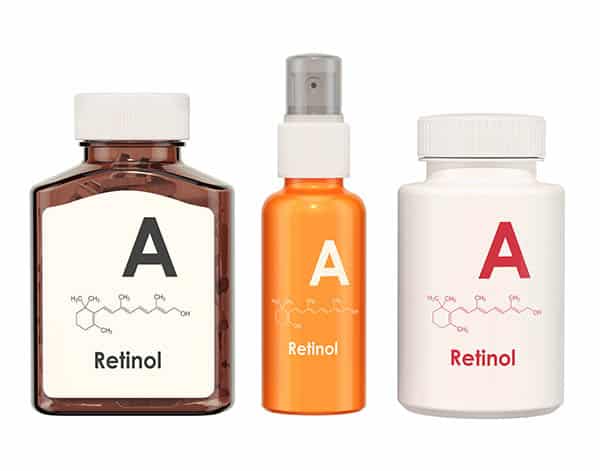Vitamin A and its derivatives are popular additions to topical skincare regimens and are considered to be some of the best options the for treatment and prevention of aging. Natural retinoids (tretinoin) and synthetic retinoids (tazarotene and adapalene) must be prescribed, whereas retinol and retinyl esters are skincare agents that can be found in over-the-counter products, such as the Zo product line. These products bind to nuclear receptors and modulate the expression of genes involved in cellular differentiation and proliferation. As such, they normalize cell keratinisation. These products may be introduced into a skincare regimen if the primary goal of the patient is skin rejuvenation and the maintenance of a youthful appearance. The main barriers to their use are side effects and tolerability, but these barriers can be overcome via appropriate selection and application.
Benefits of topical retinoids
Retinoids were introduced in 1975 by Kligman and Willis; they observed the benefits of these compounds, which included the reduction of wrinkles and surface roughness and an improvement in uneven pigmentation. Histology revealed that they also reduced corneocyte adhesion and epidermal hyperplasia while increasing collagen and elastin synthesis.
By 1980, it was found that topical retinoids play a role in blocking collagenase activity, which ultimately prevents collagen degradation. In fact, most literature discusses tretinoin in terms of retinoids showing the benefits of topical vitamin A derivatives on the skin. They enhance epidermal cell turnover and, as a result, promote the rapid loss of pigment through epidermopoiesis. These findings have been reproduced countless times in clinical studies and are the basis for recommendations made by dermatologists to individuals seeking smoother, firmer, and more evenly pigmented skin.
Continuous use of retinoids is required to see optimal results: Most of their benefits are not clinically evident prior to three months of regular use; the benefit of increasingly smooth skin, which can be noticed after a month, is an exception. Using these products long-term is required to maintain results once they are achieved, and there is no limit to the treatment duration. The exception is pregnant or breastfeeding women, who must stop using retinoids due to their teratogenic properties.
Patient tolerability
The unfortunate aspect of retinoid use is that it frequently causes retinoid dermatitis, which is characterized by redness, flaking, and sensitivity. This condition limits tolerability and is a barrier to long-term compliance. It can occur in 95% of people using tretinoin. On the other hand, retinol, which has been reported to induce similar cellular changes as retinoic acid, shows fewer adverse effects. There are few studies comparing these compounds, but it is generally presumed that retinol brings about less intense effects. These lack of side effects makes it an attractive option for patients.
Several considerations should be taken into account for patients so that their treatments are individualized, which helps increase rates of compliance. Dermatitis appears within the first two weeks of use and should settle within a month of regular use. Mild scaling and stinging, though off-putting, are advantageous and are signs of adequate dosing. The application frequency can be adjusted against this response, and patients can determine it themselves after instruction from their practitioner.
Tips for compliance
These tips for compliance have been adapted from Kligman’s original guidelines for the use of tretinoin.
- Starting with a lower strength is ideal, especially if the patient is new to the treatment. Potency can be increased over time, and it is best to start at 0.3% retinol.
- To cleanse, wash the face in the morning for comfort and at night to remove makeup and dirt. Warm water and clean hands should be used, and the skin should be dry before applying retinol. Moisturize in the morning.
- Apply the retinoid at night. Only a pea-sized amount should be used. Stinging indicates that enough has been used, and no other products should be used, as they may dilute the retinoid.
- It is of high importance to utilize the most suitable moisturizer for after-care during the day for effectively reducing symptoms like peeling; a lighter formula might be best when choosing a moisturizer for patients that have a history of acne. No matter which moisturizer is chosen, it should also be applied on those days when retinoid is not in use. If patients decide or state that they require a night moisturizer also, they should wait a period of up to 30 minutes before applying any additionally, to allow for the retinoid to be fully absorbed first.
- Adjust the frequency of application. Retinol can be introduced by gradually tapering the application frequency, especially in patients with sensitive or reactive skin. Short contact therapy is an option; this entails rinsing off the product after 30 minutes of wear.
- Although retinoids are often used on the face, they can be used on hands and forearms. The eyes and lips should be avoided because they are sensitive, but retinoids can be applied right up to the margins. Some brands have products for the eye area with a weaker strength of retinol. Retinoid use on the décolletage warrants caution because the area is so thin; application should be done every third night.
- Patients should be educated about possible side effects. Some may report no adverse effects, whereas others may experience irritation and dryness that lasts over a month. They should be reassured that this is normal; otherwise, they may quit the treatment.
- Dosing should be escalated carefully; after three months, the dose can be increased slightly, or a prescription may be appropriate and offered by a dermatologist. Higher strengths will cause irritation to occur, even if the patient did not experience it at lower concentrations, so a heavier moisturizer should be used in these cases.
- Retinoids must be used in combination with sunscreen and a moisturizer. Patients should avoid aesthetic products that may cause irritation, such as scrubs and enzyme peels, and instead opt for less abrasive alternatives. Sunscreen with a minimum SPF of 30 is mandatory, as the stratum corneum is thin and more susceptible to the damaging effects of the sun after retinoid use.
- Patients should be educated on the timing of results. The evidence for clinical benefit can take three months or more to appear, and maintenance should be kept up indefinitely. After eight months of use, retinoid application can be reduced to twice a week.
Conclusion
Over-the-counter retinoids, such as retinol, can improve the appearance of skin by increasing smoothness and reducing wrinkles and uneven pigmentation, much like what is expected from Sculptra treatment. Retinol will have the same type of effects as tretinoin, albeit to a lower degree. Retinoid dermatitis is almost unavoidable and should be expected. All side effects, instructions, and details about the product being used should be carefully explained to patients. Providing this information will result in improved patient tolerability and compliance, and patients will be more likely to see their desired results.





















